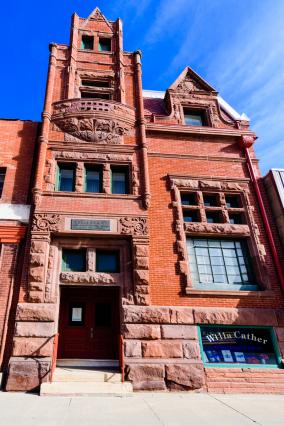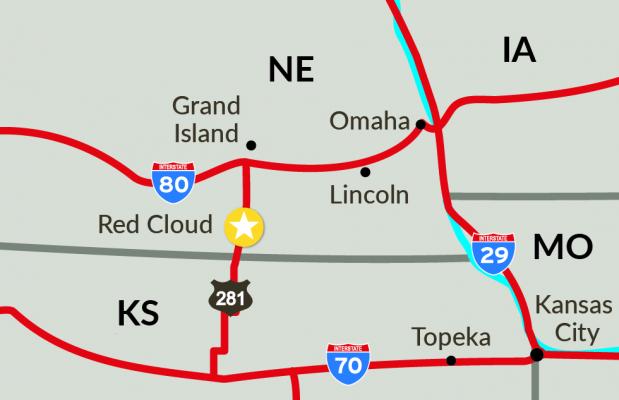Warner-Cather House also known as The Cather Second Home Guest House
In 1904 the Cather family left their little rented house on the corner of Third and Cedar and moved into this more spacious house at the corner of 6th and Seward, which they had purchased. Although Willa Cather had left Red Cloud permanently in 1896, she continued to visit her family in this house during the summers and occasionally for Christmas. The house is the setting for the Ferguesson family home in one of her short stories, "The Best Years."
Pike-Pawnee Village
Occupied from 1770 to about 1810 or later, the Pike-Pawnee National Historic Landmark has been the subject of intense historical and archeological research. Former Nebraska State Historical Society Museum Director A. T. Hill documented the site as the Republican Pawnee community visited by the 1806 Zebulon Pike expedition. It encompasses nearly 300 acres of Republican River terrace, bluffs, and draws in the Guide Rock vicinity. In addition to the village area of 100 lodge sites, there are five cemeteries, two hoop game "courts," and a council site that constitute the complex. Artifacts of both native and European origin are common.
Chalk Cliffs and Republican River
The chalk cliffs are exposed bluffs along the south edge of the Republican River just south of Red Cloud. The cliffs are a naturally occurring geologic feature, exposed by the action of the Republican River and considered a landmark in the community.
Red Cloud United States Post Office
The Red Cloud United States Post Office is a one-story, buff-colored brick building constr ucted in 1939 in the Modernistic style. While the building retains a high degree of integrity, its historical significance derives from the mural painted on an interior wall. Through New Deal programs such as the Public Works of Art Project and the WPA Federal Art Project, thousands of artists were employed. In 1934 the Section of Painting and Sculpture (renamed the Section of Fine Arts in 1938) was organized under the auspices of the Treasury Department to provide murals and sculpture for the many federal buildings constructed during the New Deal era. Between 1938 and 1942 the Treasury Department's Section of Fine Arts (generally known as "the Section") commissioned twelve murals for twelve newly constructed post offices in Nebraska. Red Cloud, along with the other eleven post office murals in Nebraska represent the Section's goal of making art accessible to the general population by reserving one percent of new building construction budgets for art.
Auld Public Library
Constructed in 1917-18, the Auld Public Library is an excellent example of educational architecture in Red Cloud. Designed in the Neo-Classical style, the building is a fine representative of early twentieth-century library design as found in communities throughout Nebraska during this period. This facility was the result of William T. Auld's generous donation to erect the first permanent library for the community.
Webster County Courthouse
The Webster County Courthouse was built in 1914. The building, a vitrified brick edifice of three stories, is designed in the Second Renaissance Revival style. Trimmed in stone, with a stone foundation, the symmetrical rectangular building features central projecting pavilions at each of its two side ends and a front, south facade that projects slightly across its entire width from the main block of the building. A high parapet above the wall cornice slopes upward slightly toward the center of each facade.
Red Cloud Republican River Bridge
The Nebraska Department of Roads and Irrigation designed the Red Cloud Bridge in 1935 after spring floods weakened the old structure. Although the highway department generally constructed simple truss spans, it instead delineated a continuous truss for the Red Cloud Bridge. The channel spans consist of three continuous pony trusses, flanked by deck girder approaches. To provide sway bracing, overhead lateral struts connect the upper chords of both webs at the bridge piers. The four main piers are constructed of concrete with up- and downstream cutwaters. The piers rest on concrete-filled tubes driven to bedrock. The approach span abutments consist of steel piles encased in concrete, with flared, sloped wingwalls. Highway department engineers took great pains to ensure that the bridge was seated properly to avoid undue stresses at the bearing points, weighing each truss with hydraulic jacks before the concrete deck was poured. The Red Cloud Bridge, located south of the town of Red Cloud, is technologically significant as a rare experimental design by the state highway department. Representing a highly unusual foray into continuous truss engineering, the Red Cloud Bridge is unique in Nebraska and is one of the state's most important vehicular spans.
Willa Cather Sites
There are also many sites on the National Register of Historic Sites associated with Willa Cather. Please visit the
attractions page for more information or visit the
Willa Cather Foundation website for more information about the sites and tour possibilities.













